Have you ever noticed how disasters and other problems tend to happen in bunches? Back around the middle of June I finally gave in to several weeks of feeling totally miserable and stumbled into my doctor's office. Turns out I was harboring ear, nose and throat infections at the same time. Before I was completely over that, my mother died and I wound up having to fight the insurance company besides playing musical funeral homes before I could get her buried. That put me back in the doctor's office being treated for severe stress (and I still wasn't completely over the original triple infection). Two days after I buried my mother, my computer's scanner died. The replacement flatbed scanner I purchased has the capability of scanning transparencies and negatives… BUT the software that came with it is more trouble than it's worth. It took another two days to install a standalone scanner program and figure out how to make it work with the scanner. Turns out that when I want to scan negs or slides, I have to start the original program, turn the transparency adapter on, shut the original program down, start the standalone program and then start scanning. When I'm finished, I have to reverse the process to turn the cottonpickin' thing off! Scanning prints doesn't require this convoluted method. Just start the standalone program and have at it. Then I made my third visit to the doctor's, this time for what turned out to a low-grade allergic reaction to the red level pollution that was blown down to my area from the Northeastern U.S. Believe me, that was one visitor I wasn't happy to see. To cap it off, in the midst of trying to work this column up, I got popped in a speed trap, courtesy of the local constabulary!! I would ask what's gonna happen next…but I'm afraid I'd find out! If you grew up on…or were already grown and took a liking to…a TV cartoon series called The Jetsons, you had a glorious vision of the future. We'd all have private spaceships instead of cars, cities would float in the sky and on and on and on. Of course, the future hasn't quite turned out that way…yet…but it sure made for an appealing cartoon.
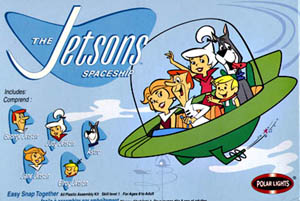 POLAR
LIGHTS has produced another kit that'll be of considerable interest
to anyone with an interest in nostalgia…or is simply drawn to kits that
are simple, quick, reasonably priced and just plain cute. The Jetsons
Spaceship, at $12.99, qualifies on all counts. POLAR
LIGHTS has produced another kit that'll be of considerable interest
to anyone with an interest in nostalgia…or is simply drawn to kits that
are simple, quick, reasonably priced and just plain cute. The Jetsons
Spaceship, at $12.99, qualifies on all counts.
Offered as an easy snap together kit, you get fourteen parts, a three-part stand, five pre-painted figures and a set of instructions. All parts are bagged, with each figure having their own bag and the clear styrene dome even being encased in a bubble wrap bag. While the instructions include optional painting colors and I discovered that a slightly different assembly sequence would work just a tad better, you can build it straight from the box with no trouble at all. You can literally snap it together (with no painting) in twenty minutes or so…and that's if you dawdle around. Believe it or not, the finished product looks pretty darned nice. The pre-painted figures of George, Jane, Judy and Elroy Jetson…and their faithful dog Astro…add a nice touch of color and realism to the otherwise unpainted spaceship. My only deviation from the instructions was to add the clear dome last instead of in Step 1. This is because it uses a twist-lock feature for installation on the top ship flange that doesn't lock tightly. Install it according to the instructions and it'll keep coming loose while you're working on the rest of the model. Instead, build the model and add the dome as the last item and you won't have any problem at all. You only build serious models of real vehicles? Then it's about time you took a break and built something just for the heck of it. The Jetsons Spaceship definitely qualifies. Besides, it's cute as a bug. 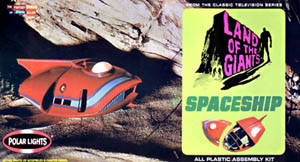 Anyone who has fond memories of the Aurora kit of the Spindrift Spaceship from Irwin Allen's Land Of The Giants TV series will love this next POLAR LIGHTS offering. They have repopped the Aurora kit and a very nice effort it is, too. Anyone who has fond memories of the Aurora kit of the Spindrift Spaceship from Irwin Allen's Land Of The Giants TV series will love this next POLAR LIGHTS offering. They have repopped the Aurora kit and a very nice effort it is, too.
The kit follows their usual retro style approach, starting with the box. Despite the POLAR LIGHTS logo, along with a few other changes, the box will have no problem triggering memories of Aurora. What's inside is just as memorable. All parts, except the clear, are molded in pale lime green and red-orange. Everything is trapped inside three bags, so there's no chance of the clear parts being damaged. This kit even includes the familiar, triangular pedestal base that was a fixture in every Aurora kit. A triangular orange w/black lettering decal for the base that says "The Land Of The Giants Space Ship" is included as well. Instructions are classic Aurora retro style. In case the collectors/investors out there are wondering, there is a little oval window on the bottom of the box that allows you to see if you're getting a kit molded in white styrene. One out of every twelve kits is produced in this color. While I haven't had a chance to build the kit, the parts look crisp and clean with virtually no flash or warped parts. With a total of some 30-odd parts, the completed model will have a complete interior, including pilot, co-pilot and stewardess figures. Incidentally, the age of the original kit shows when they refer to a 'stewardess'. The door in the side of the hull slides open and the forward top hull section (part #20) can be left loose to view the interior. This option creates its own little quandary, courtesy of Aurora. You get a better fit if the hull section is cemented in place…but then you can't see the interior. Leave the hull section loose to view the interior and you may not have that good a fit when the hull section is simply fitted in place. In fact, the instructions tell you that it'll fit better if you glue it in position. Your choice. Of course there is a third choice. Utilize some of that accumulated modeling experience and do whatever modification is necessary for the upper hull section to both be removable and fit well. Price? $21.99. By the way, if your interest runs toward lighting, WILCO! MODELS, 2826 Russell Avenue, Abilene, Texas 79605 (ph.# 915-677-7009) now has available…for a paltry $10.00 (including shipping)…parts #27 & #28 that have been recast in clear resin. This will allow you to light the engine area if you've a mind to. 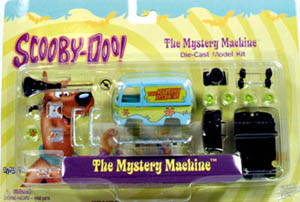 Does your interest run toward 1/64th diecast car models? Does the idea of a diecast kit intrigue you? Would you like to build a diecast car as a father/son or father/daughter project? Then take a look at an offering from JOHNNY LIGHTNING that qualifies in all areas. Does your interest run toward 1/64th diecast car models? Does the idea of a diecast kit intrigue you? Would you like to build a diecast car as a father/son or father/daughter project? Then take a look at an offering from JOHNNY LIGHTNING that qualifies in all areas.
If you liked their 1/25th scale kit of the Scooby-Doo Mystery Machine, you'll love this one. Besides being a cartoon subject that'll attract the kids…and being prepainted, requiring nothing more than a screwdriver to build (and they give you the screwdriver), it gives you a chance to spend some quality time with your kids, encourage their interest in modelbuilding and have some fun…all at the same time. And the price of all this is only $6.99. The kit itself comes in a blister pack, but don't panic. Unlike many blister packed models you see (especially kits), this one works. It's actually one blister over another that does a neat job of trapping the parts, keeping them from falling out when you get the package open. In fact, it works so well that I would suggest the gentle use of tweezers to remove the parts. Otherwise you could spend time trying to find some of the smallest parts after they've ricocheted around the room! 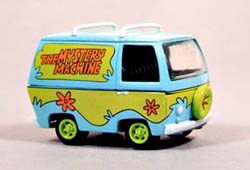 Construction moves along so rapidly that I won't bother to discuss it here. However, I will give you a heads up regarding one aspect of it. The body of the Mystery Machine is actually two parts, upper and lower. They're a simple press fit and separate very easily but come joined in the package. If you don't realize that the body comes apart, you'll wind up spending some time wondering exactly what the instructions are talking about. Construction moves along so rapidly that I won't bother to discuss it here. However, I will give you a heads up regarding one aspect of it. The body of the Mystery Machine is actually two parts, upper and lower. They're a simple press fit and separate very easily but come joined in the package. If you don't realize that the body comes apart, you'll wind up spending some time wondering exactly what the instructions are talking about.
Now go find your son or daughter and start building. 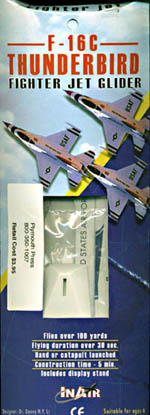 How many of us started developing an interest in model airplanes by assembling (?) and flying balsa wood gliders will probably never be known. They cost us all of 29 cents or less and probably had a lifespan of a couple of hours…if they were lucky. But they were a model plane and…in the course of that brief lifespan…they introduced untold thousands of youngsters to the magic, joy and glory of flight. How many of us started developing an interest in model airplanes by assembling (?) and flying balsa wood gliders will probably never be known. They cost us all of 29 cents or less and probably had a lifespan of a couple of hours…if they were lucky. But they were a model plane and…in the course of that brief lifespan…they introduced untold thousands of youngsters to the magic, joy and glory of flight.
Well, the cheap, hand-launched glider is still with us in a slightly updated form. Produced by IN AIR and available from PLYMOUTH PRESS, 101 Panton Road, Vergennes, Vermont 05491 (ph. 1-800-350-1007), their F-16C Thunderbird Fighter Jet Glider is intended to enthrall another generation of potential aerospace enthusiasts. Instead of balsa, the base material is foam covered with slick, self-adhesive paper. While still a profile fuselage with the familiar simple wing design, the foam base allows you to make slight changes to the control surfaces in order to adjust flight characteristics. Size is about what you'd expect: 9.8" wingspan and a length of 11.1". Price is $3.95, which is about as cheap today as 29 cents was forty years ago. Another reason for the higher price is the fact that it comes with a two-piece display stand and a catapult launcher if you choose not to hand launch. Construction time is claimed to be five minutes, though I took longer. Not because there's anything difficult about it. I just didn't want to rush it. The whole thing comes packaged in a sturdy little sleeve box with a transparent window on the front. If you're trying to figure out a way to get your son (or daughter) away from the video games, pick up one or two of these gliders and head for the park. And if the F-16 ain't your thing, an Air Force One Boeing 747 glider is also available. Last month I had to shut things down due to a pressing deadline before I could reach the bottom of a stack of books that needed reviewing. Well, pressing deadlines are a fact of life when you write for a living...or part of one...and the book stack keeps getting taller. I may not reach the bottom this time, either, but I'll try. Somebody slow that clock down! Strange things happen on occasion that actually work to a reviewer's advantage, especially if you're trying to catch up on a slew of items. That's what's occurred where my stack of books is concerned. Every one is either published or distributed by SPECIALTY PRESS (https://www.specialtypress.com). You can also find them in your friendly, neighborhood hobby shop, or local bookstore. Keep in mind that if you order from SPECIALTY PRESS, there's a $4.95 per order shipping and handling fee. The ordering information just provided will apply to each and every book reviewed below. First up is a book that will wind up on the 'must' list of anyone interested in the camouflage and markings of American fighter pilots in the ETO during WW-II. This first volume from CLASSIC PUBLICATIONS (a continuing series is planned) 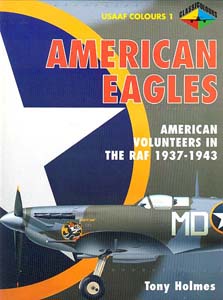 addresses an area that seems to have eluded many researchers. addresses an area that seems to have eluded many researchers. Titled AMERICAN EAGLES, American Volunteers in the RAF 1937-1943 by Tony Holmes, this large format (9"x12"), 128 page softcover book succeeds in concentrating a large amount of information on the RAF's american volunteers into a single source. An extensive collection of more than 150 photos (all b&w, of course) depicts types ranging all the way from the Gloster Gauntlet to the Supermarine Spitfire. There are plenty of descriptions of the action, both non-combat and combat, information on the fate of various pilots, the Battle of Britain, the Eagle Squadrons and a substantial section of photos showing the Spitfire wearing the American Star-in-Circle insignia. "But what about color.." you ask? British artist Mark Styling has created over 30 color profiles specifically for this book…and most of them are keyed to particular pilots in the book with peculiarities of their color schemes and/or markings being noted in the captions. And in the back is a lengthy two-page bibliography that'll lead you to many other complimentary references. Is this the definitive book on the American Eagles? Not at all and they don't claim to be. However, if you're looking for a book with the most comprehensive collection of large, early "Yanks in Britain" photos, this is the one for you. Build models of Hurricanes and Spitfires that sport British markings but were flown by American volunteers? You won't be able to do without it. Price? A very reasonable $24.95. 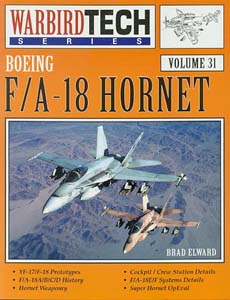 The SPECIALTY PRESS WarbirdTech Series continues with Volume 31, the Boeing F/A-18 Hornet by Brad Elward. Boeing? If you were born more than five years ago, you know that the aircraft was originally manufactured by McDonnell-Douglas. Thanks to merger mania, McDonnell-Douglas was acquired by Boeing, which meant that the McDonnell-Douglas F/A-18 is now the Boeing F/A-18. In another 5-10 years, the only people who'll remember the McDonnell-Douglas F/A-18 will be on the far side of 50. The SPECIALTY PRESS WarbirdTech Series continues with Volume 31, the Boeing F/A-18 Hornet by Brad Elward. Boeing? If you were born more than five years ago, you know that the aircraft was originally manufactured by McDonnell-Douglas. Thanks to merger mania, McDonnell-Douglas was acquired by Boeing, which meant that the McDonnell-Douglas F/A-18 is now the Boeing F/A-18. In another 5-10 years, the only people who'll remember the McDonnell-Douglas F/A-18 will be on the far side of 50.
Be that as it may, the book follows the standard WarbirdTech Series format. 8 1/2" x 11" vertical format, heavyweight semi-stiff covers, 104 pages, glossy enamel stock, 160 b&w photos, 8 pages of color and a drop-dead price of $16.95. Brad Elward has done an excellent job of detailing the origin of the Hornet. From there he works his way thru all other variants, including development of F/A-18E/F…or Super Hornet. Appendices include a four-page listing of both U.S. and International operators and a two-page list of significant dates. Photograph selection is excellent. Modelers will love them because a large number of them are tightly cropped to show specific detail. No danger that you'll be buying a collection of distant beauty shots and nothing else. Will you find that kind in this book? Sure, and you wouldn't want it if it didn't. The point is that the photo selection is very nicely balanced. Then there's the color shots. You'll find an extremely colorful gray-and-blue Canadian bird on the first color page. The rest of the color photos are of U.S. birds in various schemes. Quite a few are of the Super Hornet, but you'll find the earlier variants as well. How about an F/A-18A in 2-tone blue cammy, ala the Su-27? Or an F/A-18C in colorful CAG markings? Or an F/A-18B in 3-tone desert camouflage? Or…well you get the idea. And cockpit detail buffs will love the full-page color shot of the instrument display screens fully lit in a simulator. I could go on, but there's no point. If you like the F/A-18 Hornet, go buy the book. 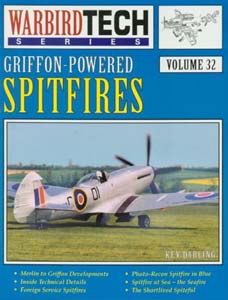 WarbirdTech Series keeps adding more and more titles to their line. Volume 32 is titled Griffon-powered Spitfires by Kev Darling. This volume is very tightly focused, concentrating strictly on the Griffon-engined versions of the venerable Spitfire. Format, number of pages, photos, content is essentially identical to the Hornet book. WarbirdTech Series keeps adding more and more titles to their line. Volume 32 is titled Griffon-powered Spitfires by Kev Darling. This volume is very tightly focused, concentrating strictly on the Griffon-engined versions of the venerable Spitfire. Format, number of pages, photos, content is essentially identical to the Hornet book.
This version of the Spitfire offered greater power, range, firepower and more. It also had the misfortune to come into being just as jet fighters were beginning their ascendancy. The last version of the immortal Spitfire, the Seafire FR47, would see combat over Korea, a worthy end for a true thoroughbred. If you like Spitfires and want your bookshelf to include a complete history of the line, think about adding this volume to it. 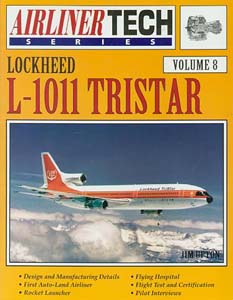 A companion series to the WarbirdTech Series, using exactly the same format, is called AirlinerTech Series. Anyone who's preferences lies with airliners is making a large mistake if they're not familiar with this series. A companion series to the WarbirdTech Series, using exactly the same format, is called AirlinerTech Series. Anyone who's preferences lies with airliners is making a large mistake if they're not familiar with this series.
Volume 8 is titled Lockheed L-1011 Tristar by Jim Upton. Airliner references aren't that easy to find in the first place, making the entire AirlinerTech Series a must series for the airliner enthusiast. Beyond that, at least from what I've run across over the years, reference material on the L-1011 is even harder to come by. Jim Upton has done an excellent job of recording the history of the L-1011, all the way from the initial concept to a listing of the various airlines and other operators still using the aircraft. In between, you get all the technical data, discussion of the different cabin layouts and such unusual uses as a flying hospital and rocket launcher for the Pegasus three-stage rocket. It was also intended to launch the X-34 before that program was canceled. Not a bad range of uses for an aircraft that most people think of as 'just another airliner'. The b&w photos certainly do justice to the aircraft, including both overall shots with a wide variety of airline markings and close-up detail photos. In the color section you'll find a couple of excellent color shots of the first TriStar in Lockheed Company markings (and on the cover as well). A nighttime flightline shot shows L-1011s in various airline liveries sitting side by each. Other photos depict the cabin interior, cockpit, flight engineer's station and an L-1011 with a fourth engine mounted under the wing on a temporary pylon for long distance transportation of a spare. Appendices include a four-page production list, another page of specs and one more listing significant dates. If you're planning on building a TriStar model, plan on acquiring a copy of this book at the same time. And that, folks, is about it for this issue. I could go on, but since I've made a pretty good dent in the stack, I think I'll let discretion be the better part of valor and save the rest for next month. | 








|
 POLAR
LIGHTS has produced another kit that'll be of considerable interest
to anyone with an interest in nostalgia…or is simply drawn to kits that
are simple, quick, reasonably priced and just plain cute. The Jetsons
Spaceship, at $12.99, qualifies on all counts.
POLAR
LIGHTS has produced another kit that'll be of considerable interest
to anyone with an interest in nostalgia…or is simply drawn to kits that
are simple, quick, reasonably priced and just plain cute. The Jetsons
Spaceship, at $12.99, qualifies on all counts. Anyone who has fond memories of the Aurora kit of the Spindrift Spaceship from Irwin Allen's Land Of The Giants TV series will love this next POLAR LIGHTS offering. They have repopped the Aurora kit and a very nice effort it is, too.
Anyone who has fond memories of the Aurora kit of the Spindrift Spaceship from Irwin Allen's Land Of The Giants TV series will love this next POLAR LIGHTS offering. They have repopped the Aurora kit and a very nice effort it is, too. Does your interest run toward 1/64th diecast car models? Does the idea of a diecast kit intrigue you? Would you like to build a diecast car as a father/son or father/daughter project? Then take a look at an offering from JOHNNY LIGHTNING that qualifies in all areas.
Does your interest run toward 1/64th diecast car models? Does the idea of a diecast kit intrigue you? Would you like to build a diecast car as a father/son or father/daughter project? Then take a look at an offering from JOHNNY LIGHTNING that qualifies in all areas. Construction moves along so rapidly that I won't bother to discuss it here. However, I will give you a heads up regarding one aspect of it. The body of the Mystery Machine is actually two parts, upper and lower. They're a simple press fit and separate very easily but come joined in the package. If you don't realize that the body comes apart, you'll wind up spending some time wondering exactly what the instructions are talking about.
Construction moves along so rapidly that I won't bother to discuss it here. However, I will give you a heads up regarding one aspect of it. The body of the Mystery Machine is actually two parts, upper and lower. They're a simple press fit and separate very easily but come joined in the package. If you don't realize that the body comes apart, you'll wind up spending some time wondering exactly what the instructions are talking about. How many of us started developing an interest in model airplanes by assembling (?) and flying balsa wood gliders will probably never be known. They cost us all of 29 cents or less and probably had a lifespan of a couple of hours…if they were lucky. But they were a model plane and…in the course of that brief lifespan…they introduced untold thousands of youngsters to the magic, joy and glory of flight.
How many of us started developing an interest in model airplanes by assembling (?) and flying balsa wood gliders will probably never be known. They cost us all of 29 cents or less and probably had a lifespan of a couple of hours…if they were lucky. But they were a model plane and…in the course of that brief lifespan…they introduced untold thousands of youngsters to the magic, joy and glory of flight. addresses an area that seems to have eluded many researchers.
addresses an area that seems to have eluded many researchers.  The SPECIALTY PRESS WarbirdTech Series continues with Volume 31, the Boeing F/A-18 Hornet by Brad Elward. Boeing? If you were born more than five years ago, you know that the aircraft was originally manufactured by McDonnell-Douglas. Thanks to merger mania, McDonnell-Douglas was acquired by Boeing, which meant that the McDonnell-Douglas F/A-18 is now the Boeing F/A-18. In another 5-10 years, the only people who'll remember the McDonnell-Douglas F/A-18 will be on the far side of 50.
The SPECIALTY PRESS WarbirdTech Series continues with Volume 31, the Boeing F/A-18 Hornet by Brad Elward. Boeing? If you were born more than five years ago, you know that the aircraft was originally manufactured by McDonnell-Douglas. Thanks to merger mania, McDonnell-Douglas was acquired by Boeing, which meant that the McDonnell-Douglas F/A-18 is now the Boeing F/A-18. In another 5-10 years, the only people who'll remember the McDonnell-Douglas F/A-18 will be on the far side of 50.  WarbirdTech Series keeps adding more and more titles to their line. Volume 32 is titled Griffon-powered Spitfires by Kev Darling. This volume is very tightly focused, concentrating strictly on the Griffon-engined versions of the venerable Spitfire. Format, number of pages, photos, content is essentially identical to the Hornet book.
WarbirdTech Series keeps adding more and more titles to their line. Volume 32 is titled Griffon-powered Spitfires by Kev Darling. This volume is very tightly focused, concentrating strictly on the Griffon-engined versions of the venerable Spitfire. Format, number of pages, photos, content is essentially identical to the Hornet book. A companion series to the WarbirdTech Series, using exactly the same format, is called AirlinerTech Series. Anyone who's preferences lies with airliners is making a large mistake if they're not familiar with this series.
A companion series to the WarbirdTech Series, using exactly the same format, is called AirlinerTech Series. Anyone who's preferences lies with airliners is making a large mistake if they're not familiar with this series.






